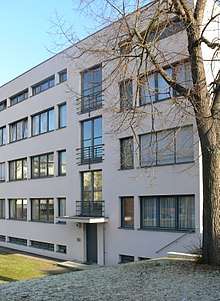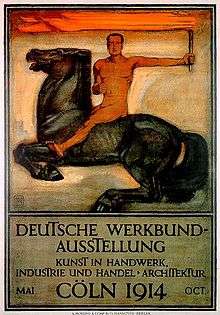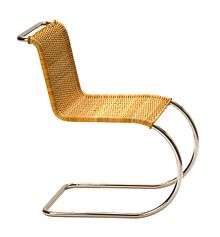Deutscher Werkbund



The Deutscher Werkbund (German Association of Craftsmen) is a German association of artists, architects, designers, and industrialists, established in 1907. The Werkbund became an important element in the development of modern architecture and industrial design, particularly in the later creation of the Bauhaus school of design. Its initial purpose was to establish a partnership of product manufacturers with design professionals to improve the competitiveness of German companies in global markets. The Werkbund was less an artistic movement than a state-sponsored effort to integrate traditional crafts and industrial mass production techniques, to put Germany on a competitive footing with England and the United States. Its motto Vom Sofakissen zum Städtebau (from sofa cushions to city-building) indicates its range of interest.
History
The Deutscher Werkbund emerged when the architect Joseph Maria Olbrich left Vienna for Darmstadt, Germany, in 1899, to form an artists’ colony at the invitation of Ernest Louis, Grand Duke of Hesse.[2] The Werkbund was founded by Olbrich, Peter Behrens, Richard Riemerschmid, Bruno Paul and others in 1907[2] in Munich at the instigation of Hermann Muthesius, existed through 1934, then re-established after World War II in 1950. Muthesius was the author of the exhaustive three-volume "The English House" of 1905, a survey of the practical lessons of the English Arts and Crafts movement. Muthesius was seen as something of a cultural ambassador, or industrial spy, between Germany and England.
The organization originally included twelve architects and twelve business firms. The architects include Peter Behrens, Theodor Fischer (who served as its first president), Josef Hoffmann, Bruno Paul, and Richard Riemerschmid. Other architects affiliated with the project include Heinrich Tessenow and the Belgian Henry van de Velde. The Werkbund commissioned van de Velde to design a theatre for its 1914 Cologne Exhibition in Cologne. The exhibition was closed and the buildings dismantled, ahead of schedule, because of the outbreak of WW I. Eliel Saarinen was made corresponding member of the Deutscher Werkbund in 1914 and was invited to participate in the 1914 Cologne exhibition. Among the Werkbund's more noted members was the architect Ludwig Mies Van der Rohe, who served as Architectural Director.
Key dates of the Deutscher Werkbund
- 1907, Establishment of the Werkbund in Munich
- 1910, Salon d'Automne, Paris
- 1914, Cologne exhibition
- 1920, Lilly Reich becomes the first female Director
- 1924, Berlin exhibition
- 1927, Stuttgart exhibition (including the Weissenhof Estate)
- 1929, Breslau exhibition
- 1938, Werkbund closed by the Nazis
- 1949, Reestablishment
100th anniversary
The Verband Deutscher Industrie Designer (Association of German Industrial Designers, or VDID) and the Bund Deutscher Grafik-Designer Federation of German Graphic Designers (BDG-Mitte) held a joint meeting to celebrate the 100th anniversary of the Deutscher Werkbund. A juried exhibition and opening was held on March 14, 2008.[3][4]
Museum der Dinge
The collections and archives (Werkbundarchiv) of the Werkbund are housed at the Museum der Dinge (Museum of Things) in Berlin. The museum is focused on design and objects used in everyday life in the 20th century up to the present. Among other exhibits, it includes a Frankfurt kitchen.
See also
References
- ↑ http://www.cmoa.org/CollectionDetail.aspx?item=1022315
- 1 2 Wendy Moonan (December 7, 2007), German Design for an Industrial Age The New York Times.
- ↑ Werkbund Museum
- ↑ VDID Events page Archived 2007-07-17 at the Wayback Machine.
Further reading
- Lucius Burckhardt (1987). The Werkbund. Hyperion Press. ISBN 0-85072-108-3
- Frederic J. Schwartz (1996). The Werkbund: Design Theory and Mass Culture Before the First World War. New Haven, Conn. : Yale University Press. ISBN 0-300-06898-0
- Mark Jarzombek. "Joseph August Lux: Werkbund Promoter, Historian of a Lost Modernity," Journal of the Society of Architectural Historians 63/1 (June 2004): 202-219.
- Ot Hoffmann im Auftrag des DWB: Der Deutsche Werkbund – 1907, 1947, 1987. Wilhelm Ernst & Sohn, Frankfurt 1987, ISBN 3-433-02268-2. (in German)
- Yuko Ikeda: Vom Sofakissen zum Städtebau. Hermann Muthesius und der Deutsche Werkbund. Modern Design in Deutschland 1900–1927. Ausstellungskatalog. The National Museum of Modern Art, Kyoto 2002, ISBN 4-87642-165-X.
- Karl-Ernst-Osthaus-Museum Hagen und Kaiser-Wilhelm-Museum Krefeld: Das Schöne und der Alltag – Deutsches Museum für Kunst in Handel und Gewerbe. Ausstellungskatalog. Pandora Snoeck-Ducaju & Zoon, Gent 1997, ISBN 90-5325-090-5. (in German)
External links
![]()
- Official website
- Werkbundarchiv: Museum der Dinge - official site